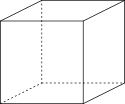LC 00489: verschil tussen versies
Geen bewerkingssamenvatting |
Geen bewerkingssamenvatting |
||
| (15 tussenliggende versies door dezelfde gebruiker niet weergegeven) | |||
| Regel 1: | Regel 1: | ||
Laws of Form showed in a formal way that the observer and observed coincide. In particular, the mark of distinction (˥) established the relation between distinction and indication: there cannot be a distinction without indication, and the other way round. The distinction severs a space in a marked and an unmarked state. An observer can observe only the marked side of the distinction in the act of observing, the other side is his blind spot. So, everyone has blind spots, which you can put to the test by yourself by observing the Necker cube and the Rubin vase. | |||
''''' | The cube can be viewed from two perspectives, but not at the same time. | ||
[[Bestand:Cube I.png|gecentreerd|miniatuur|'''Figure:''' viewing a cube from two perspectives.]] | |||
If you have trouble seeing both perspectives, then the dotted, hidden edges might help to discern them.[[Bestand:Cube IIa.png|gecentreerd|miniatuur|'''Figure:''' first perspective to view the cube from.]] | |||
[[Bestand:Cube IIb.png|gecentreerd|miniatuur|'''Figure:''' second perspective to view the cube from.]] | |||
You see the vase or the two silhouettes, but again, not at the same time. | |||
'''''The distinction | [[Bestand:Vase silhouettes.png|gecentreerd|miniatuur|'''Figure:''' do you see a vase or do you see the silhouettes?]] | ||
At any one time, one view is perceived, whereas the other view is currently in your blind spot. Not only in the moment you perceive you have a blind spot, but the very way you perceive things have its (implicit) blind spots as well because of the distinctions you apply. A worldview, i.e., the distinctions you make, provides a way to look at the world, like glasses. It is how we look, and we do not know what we miss by perceiving the world according to our worldview (glasses). That is, everyone has its blind spots. Critical thinking is about shifting the attention from first order observations (observing the object (O)) to second order observations (observing the worldview (WV)). You need someone else to point out your blind spots to you. | |||
[[Bestand:Observing.png|gecentreerd|miniatuur|601x601px|First-order and second-order observers.]] | |||
When you look at an object in the outside world, you are a first-order observer. A second-order observer observes how a first-order observer observes the outside world. So, the focus of attention is switched to ''how'' one looks, instead of ''what'' one sees. This is an important shift because it opens the possibility to thoroughly think through questions like: why is someone doing or saying things the way he does or says? The answers can be found in observing the distinctions that are made by taking a second-order point of view. | |||
{{Include WGTM statement | |||
|WGTM Aspect=Critical Reflection | |||
|WGTM Statement=You need someone else to point out your blind spots to you. | |||
}} | |||
A second-order observer observing himself as a first-order observer leads to a paradox. As a second-order observer, you see both sides of the distinction, including your own blind spot, which is then no blind spot anymore. Again, this paradox is, as usual by now, de-paradoxified in time. First of all, every observer does have a blind spot regardless of whether a first-order or second-order observer position is taken. In the very act of observing, you see only one side of a distinction. What you see as a second-order observer observing yourself is what you once were in relation to the world. | |||
<!-- :<math>\overline{\underline{\overline{_{|} I|}world}\Big|}</math> --> | |||
[[Bestand:I World def.jpg|kaderloos|318x318px]] or equivalently [[Bestand:I World reentry.jpg|kaderloos|321x321px]] | |||
The distinction <math>\overline{I|}world</math> is re-entered in its own identical space. But the re-entered mark of distinction has become a mark that cannot be crossed anymore. The past is the past, and there is nothing you can do about it. The distinction is taken as an indivisible whole indicating your actions and the resulting reactions of the world in the past. | |||
{{Include WGTM statement | {{Include WGTM statement | ||
|WGTM Aspect=Critical Reflection | |WGTM Aspect=Critical Reflection | ||
|WGTM Statement=Concentrate on how to look, instead of what to see. | |WGTM Statement=Concentrate on how to look, instead of what to see. | ||
}} | }}Incidentally, by conceptualizing self-reflection as a second-order observation observing yourself, it becomes clear that history does matter. Things done in the past shape present and future actions. As Gadamer argues, {{Cite|resource=Resource Bibliographic Reference 00075|name=we cannot escape tradition|dialog=process-bibliographicreference-dialog}}. Tradition is overarching, which also holds for applying the scientific method in human sciences. To put it bluntly, the scientific method objectifies the present but without taking into consideration what we used to do and why, that is, our tradition. But tradition cannot be brushed away from human life, and that, ironically, applies for the way we conduct scientific research as well because the scientific method itself evolves in time due to new insights. Thus, tradition is overarching, but it also evolves. | ||
{{LC Book config}} | {{LC Book config}} | ||
{{Light Context | {{Light Context | ||
| Regel 31: | Regel 38: | ||
|Show VE button=Ja | |Show VE button=Ja | ||
|Show title=Ja | |Show title=Ja | ||
}} | |||
}} | |||
{{LC Book additional | {{LC Book additional | ||
|Preparatory reading=LC 00488 | |Preparatory reading=LC 00488 | ||
|Continue reading=LC 00457 | |Continue reading=LC 00457 | ||
}} | }} | ||
Huidige versie van 5 jul 2023 om 17:23
Laws of Form showed in a formal way that the observer and observed coincide. In particular, the mark of distinction (˥) established the relation between distinction and indication: there cannot be a distinction without indication, and the other way round. The distinction severs a space in a marked and an unmarked state. An observer can observe only the marked side of the distinction in the act of observing, the other side is his blind spot. So, everyone has blind spots, which you can put to the test by yourself by observing the Necker cube and the Rubin vase.
The cube can be viewed from two perspectives, but not at the same time.
If you have trouble seeing both perspectives, then the dotted, hidden edges might help to discern them.
You see the vase or the two silhouettes, but again, not at the same time.
At any one time, one view is perceived, whereas the other view is currently in your blind spot. Not only in the moment you perceive you have a blind spot, but the very way you perceive things have its (implicit) blind spots as well because of the distinctions you apply. A worldview, i.e., the distinctions you make, provides a way to look at the world, like glasses. It is how we look, and we do not know what we miss by perceiving the world according to our worldview (glasses). That is, everyone has its blind spots. Critical thinking is about shifting the attention from first order observations (observing the object (O)) to second order observations (observing the worldview (WV)). You need someone else to point out your blind spots to you.
When you look at an object in the outside world, you are a first-order observer. A second-order observer observes how a first-order observer observes the outside world. So, the focus of attention is switched to how one looks, instead of what one sees. This is an important shift because it opens the possibility to thoroughly think through questions like: why is someone doing or saying things the way he does or says? The answers can be found in observing the distinctions that are made by taking a second-order point of view.
Statement: You need someone else to point out your blind spots to you.
Aspect: Critical Reflection, Principle: Create room for change, Principle page: Principles and Ground Rules
| Statement page | Statement |
|---|---|
| Determining Boundary Judgements with CSH | A constructive dialog can take place on the basis of first and second order boundary judgments. |
| Self-observation | Concentrate on how to look, instead of what to see. |
| Self-observation | You need someone else to point out your blind spots to you. |
Principles, aspects and statements overview
- Create room for change, defined in page: Principles and Ground Rules
- Systems Thinking, defined in page: Principles and Ground Rules
- Hard Systems Thinking – System Dynamics (A system comprised of a number of interacting feedback loops is a complex system whose behavior can surprise us.)
- Systems Thinking (A system as a whole is comprised of parts. Systems thinking is about understanding the interactions between the parts.)
- Critical Reflection, defined in page: Principles and Ground Rules
- Determining Boundary Judgements with CSH (A constructive dialog can take place on the basis of first and second order boundary judgments.)
- Self-observation (Concentrate on how to look, instead of what to see.)
- Self-observation (You need someone else to point out your blind spots to you.)
- Diversity in opinions, defined in page: Principles and Ground Rules
- Worldview, defined in page: Principles and Ground Rules
- Model Building - Human Activity Systems (A worldview (Weltanschauung) captures the beliefs, desires and intentions of a person.)
- Model Building - Human Activity Systems (The PQR formula (what, how, why) is pivotal for capturing worldviews.)
- Soft Systems Thinking – Soft Systems Methodology (People differ in worldviews, but nevertheless they typically adhere to aspects of multiple worldviews, which provides room for accommodation.)
- We got to move, defined in page: Principles and Ground Rules
- Reflexive Domain, defined in page: Principles and Ground Rules
- Exploring Change (The constant factor in life is movement.)
- Self-Reference in a Three-Valued System (Embrace the paradox, i.e., a difference in what was previously stated and therefore contradicting what was said before. Differences keep setting things in motion. Without differences we cease to exist. Therefore, change is inevitable, in fact, it is a necessity for living.)
- The Autopoietic Turn (Humans and social systems operate autonomously and my react when irritated.)
- Tradition, defined in page: Principles and Ground Rules
- Exploring Change (A system has to become what it is not, and yet remain the same.)
- Some-thing from No-thing (The relationship between things, including humans, is what matters. Something or someone cannot stand or be taken on its own.)
- Determine the right direction, defined in page: Principles and Ground Rules
- Cultural Identity, defined in page: Principles and Ground Rules
- Investigating Identity (Group identity refers to a person’s sense of belonging to a particular group.)
- Research Philosophy and Process (Research approach must be “for you, and with you”, instead of “for you, but not with you”.)
- Right Things, defined in page: Principles and Ground Rules
- Co-dependency, defined in page: Principles and Ground Rules
- Ethics of Care, defined in page: Principles and Ground Rules
- Investigating Identity (Ethics of Care is a retreat to first principles to be part of a group to protect and to provide meaning.)
- Responsible Setting for Social Innovation (Each stakeholder facilitates other stakeholders in addressing a societal challenge.)
- Some-thing from No-thing (We rely on each other and therefore we should care for each other.)
A second-order observer observing himself as a first-order observer leads to a paradox. As a second-order observer, you see both sides of the distinction, including your own blind spot, which is then no blind spot anymore. Again, this paradox is, as usual by now, de-paradoxified in time. First of all, every observer does have a blind spot regardless of whether a first-order or second-order observer position is taken. In the very act of observing, you see only one side of a distinction. What you see as a second-order observer observing yourself is what you once were in relation to the world.
 or equivalently
or equivalently 
The distinction [math]\displaystyle{ \overline{I|}world }[/math] is re-entered in its own identical space. But the re-entered mark of distinction has become a mark that cannot be crossed anymore. The past is the past, and there is nothing you can do about it. The distinction is taken as an indivisible whole indicating your actions and the resulting reactions of the world in the past.
Statement: Concentrate on how to look, instead of what to see.
Aspect: Critical Reflection, Principle: Create room for change, Principle page: Principles and Ground Rules
| Statement page | Statement |
|---|---|
| Determining Boundary Judgements with CSH | A constructive dialog can take place on the basis of first and second order boundary judgments. |
| Self-observation | Concentrate on how to look, instead of what to see. |
| Self-observation | You need someone else to point out your blind spots to you. |
Principles, aspects and statements overview
- Create room for change, defined in page: Principles and Ground Rules
- Systems Thinking, defined in page: Principles and Ground Rules
- Hard Systems Thinking – System Dynamics (A system comprised of a number of interacting feedback loops is a complex system whose behavior can surprise us.)
- Systems Thinking (A system as a whole is comprised of parts. Systems thinking is about understanding the interactions between the parts.)
- Critical Reflection, defined in page: Principles and Ground Rules
- Determining Boundary Judgements with CSH (A constructive dialog can take place on the basis of first and second order boundary judgments.)
- Self-observation (Concentrate on how to look, instead of what to see.)
- Self-observation (You need someone else to point out your blind spots to you.)
- Diversity in opinions, defined in page: Principles and Ground Rules
- Worldview, defined in page: Principles and Ground Rules
- Model Building - Human Activity Systems (A worldview (Weltanschauung) captures the beliefs, desires and intentions of a person.)
- Model Building - Human Activity Systems (The PQR formula (what, how, why) is pivotal for capturing worldviews.)
- Soft Systems Thinking – Soft Systems Methodology (People differ in worldviews, but nevertheless they typically adhere to aspects of multiple worldviews, which provides room for accommodation.)
- We got to move, defined in page: Principles and Ground Rules
- Reflexive Domain, defined in page: Principles and Ground Rules
- Exploring Change (The constant factor in life is movement.)
- Self-Reference in a Three-Valued System (Embrace the paradox, i.e., a difference in what was previously stated and therefore contradicting what was said before. Differences keep setting things in motion. Without differences we cease to exist. Therefore, change is inevitable, in fact, it is a necessity for living.)
- The Autopoietic Turn (Humans and social systems operate autonomously and my react when irritated.)
- Tradition, defined in page: Principles and Ground Rules
- Exploring Change (A system has to become what it is not, and yet remain the same.)
- Some-thing from No-thing (The relationship between things, including humans, is what matters. Something or someone cannot stand or be taken on its own.)
- Determine the right direction, defined in page: Principles and Ground Rules
- Cultural Identity, defined in page: Principles and Ground Rules
- Investigating Identity (Group identity refers to a person’s sense of belonging to a particular group.)
- Research Philosophy and Process (Research approach must be “for you, and with you”, instead of “for you, but not with you”.)
- Right Things, defined in page: Principles and Ground Rules
- Co-dependency, defined in page: Principles and Ground Rules
- Ethics of Care, defined in page: Principles and Ground Rules
- Investigating Identity (Ethics of Care is a retreat to first principles to be part of a group to protect and to provide meaning.)
- Responsible Setting for Social Innovation (Each stakeholder facilitates other stakeholders in addressing a societal challenge.)
- Some-thing from No-thing (We rely on each other and therefore we should care for each other.)
Incidentally, by conceptualizing self-reflection as a second-order observation observing yourself, it becomes clear that history does matter. Things done in the past shape present and future actions. As Gadamer argues, we cannot escape tradition (Hans-Georg Gadamer, 1 januari 1960). Tradition is overarching, which also holds for applying the scientific method in human sciences. To put it bluntly, the scientific method objectifies the present but without taking into consideration what we used to do and why, that is, our tradition. But tradition cannot be brushed away from human life, and that, ironically, applies for the way we conduct scientific research as well because the scientific method itself evolves in time due to new insights. Thus, tradition is overarching, but it also evolves.
- Lees hiervoor:
- Lees hierna:
Referenties
- Truth and Method (Wahrheit und Methode), Hans-Georg Gadamer, 1 januari 1960.





